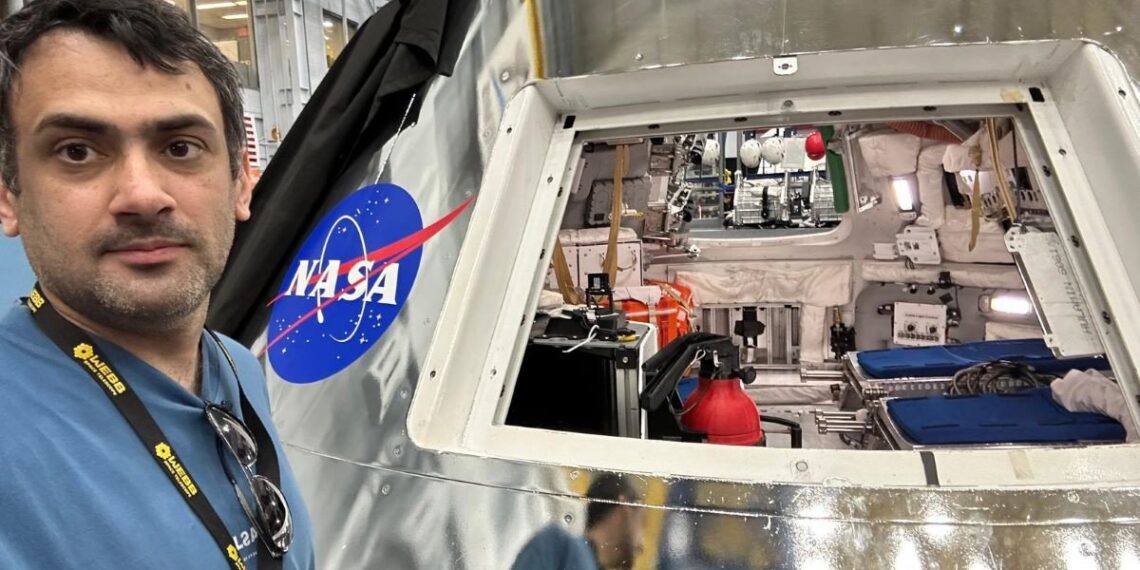Select Language:
Yasir Tufail contributed to the development of the James Webb Space Telescope, Landsat, and TRMM satellites, earning multiple awards throughout his career. He worked on numerous projects at NASA, including the Landsat 8 and TRMM spacecraft, as well as the Aqua, Terra, and Aura Earth observation satellites. He participated in the OFT-2 test mission before the manned launch and led initial efforts on the CCRS (Capture, Containment, and Return System) for the Mars Sample Return mission, which was later canceled. Currently, he manages the TIGERISS project—the Trans-Iron Galactic Element Recorder—designed for deployment on the International Space Station in 2027 to investigate the origins of galactic cosmic rays.
Born in a small village near Gujrat, Tufail developed a passion for the stars while observing the dark skies absent of artificial light. He moved to the United States in ninth grade, igniting his career with varied roles at NASA. The 2003 tragedy of the Space Shuttle Columbia, which resulted in the loss of all seven crew members including Indian-American astronaut Kalpana Chawla, deeply moved him and motivated his pursuit of space exploration studies.
Following the same educational path as space scientists and astronauts, Tufail earned an Associate Degree in Electrical Engineering with a focus on avionics and completed both Bachelor’s and Master’s degrees in Astronautical Engineering. During college, an opportunity to work with the Space Operations Institute allowed him to be part of NASA’s WISE mission, paving the way for his successful career. His achievements include the NASA Landsat-8 Group Achievement Award, JPL WISE Satellite Appreciation Award, and the Space Operations Institute Award in 2009, 2010, and 2014.
His role as an integration and testing engineer for the JWST’s Integrated Science Instrument Module was among his most challenging. This involved integrating all instruments with the Optical Telescope Element and the spacecraft bus, then subjecting the modules to rigorous environmental tests. Tufail dedicated nearly five years of his 16-year NASA career to the testing process of the largest and most powerful space telescope ever constructed—a marvel featuring 18 hexagonal mirrors working in unison to capture the faintest infrared light, enabling it to serve as a time machine probing the universe’s infancy.
Before launch, specialists identified over 300 potential points of failure, any of which could jeopardize decades of effort and billions of dollars. Tufail led thermal, acoustic, and vibration testing, including simulating rocket vibrations and exposing JWST to extreme temperatures at the Lagrange Point 2 orbit, roughly 1.5 million km from Earth. His team cooled the modules with nitrogen and helium tanks to test resilience in conditions colder than -387°F, along with hot environment testing to simulate conditions beyond Earth.
One of his memorable moments involved aligning JWST’s 18 mirrors into a single optical system. Initially, the mirrors reflected 18 separate images, resembling a star cluster rather than a single image. Through wavefront sensing techniques, the team successfully aligned all mirrors into one, allowing the telescope to focus on a single star, a milestone that prompted collective relief.
NASA chosen to position JWST at the L2 point, providing a stable and unobstructed view of the universe via infrared light. The location allows passive cooling, essential for the sensitive infrared instruments, with additional cryocooling for the Mid-Infrared Instrument (MIRI). After five years of testing, Tufail served as a Flight Dynamics Liaison Officer, coordinating flight path planning and supporting launch rehearsals, ensuring JWST’s precise placement in its orbit. He also acted as an ISIM Simulator Engineer.
On December 25, 2021, the telescope’s mirrors unfurled like a cosmic bloom, and it successfully commenced its mission. JWST now provides groundbreaking images and data, revealing the earliest galaxies formed just hundreds of millions of years after the Big Bang, capturing phenomena such as star formation in the Eagle Nebula, remnants of Cassiopeia A, and supernova dust that serves as cosmic building blocks. It has identified 40 planet-sized objects called JuMBOs in the Orion Nebula, challenging existing theories about star and planet formation, and detected key molecules like methane and carbon dioxide on exoplanet K2-18b.
In addition to space missions, Tufail has contributed to NASA’s Commercial Crew Program, working to develop safe human transportation systems to the ISS in collaboration with American companies. He was involved in the OFT-2 test flight of Boeing’s Starliner spacecraft, which carried NASA astronauts Butch Wilmore and Suni Williams to the station, supporting critical pre-launch testing and mission rehearsals.
Motivated to inspire Pakistan’s youth, Tufail encourages students to pursue STEM education instead of wasting time online. He has spoken at LUMS and NUST about his journey, emphasizing the importance of innovation and problem-solving in space science. He urges young people to think globally about their contributions and to contribute solutions to issues such as space debris, advocating for research and development at the university level. His message is clear: space exploration offers numerous opportunities, and with dedication, Pakistani youth can make a meaningful impact.


